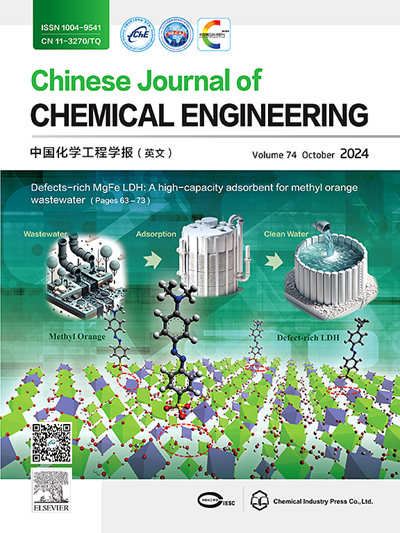杂多酸负载纳米二氧化硅催化剂氧化甲基丙烯醛
IF 3.7
3区 工程技术
Q2 ENGINEERING, CHEMICAL
引用次数: 0
摘要
在本研究中,采用两步原位分子束外延法合成了一种催化剂,在胺化处理的SiO2纳米颗粒上生长H4PMo11VO40 (HPAV),该纳米颗粒同时作为掺杂剂和宿主剂。用(3-氨基丙基)三乙氧基硅烷(APTS)修饰SiO2掺杂剂,促进了铵离子的形成,增强了SiO2掺杂剂的整体正电荷。这种修饰使HPAV的活性物质有效地分散和暴露,并诱导HPAV从三斜晶向立方晶转变。两步承载生长工艺优化了Cs+、H+和NH4+抗核离子的比例,从而微调了氧化和酸性的协同催化作用,以及HPAV催化界面处的氧化敏感性。合成的8(HPAV)&4(Cs3PAV)-NH2-SiO2催化剂的甲基丙烯(MAL)转化率为84%,甲基丙烯酸(MAA)选择性为71%。即使在10.5 h的反应时间后,催化剂仍保持其高分散性、立方晶体结构和Keggin构型,在连续200 h的反应周期内表现出稳定的催化性能。本文章由计算机程序翻译,如有差异,请以英文原文为准。

Heteropolyacid hosted to nano-silica catalyst for the oxidation of methacrolein
In this study, a catalyst was synthesized using a two-step in-situ molecular beam epitaxy method to grow H4PMo11VO40 (HPAV) on amination-treated SiO2 nanoparticles, which served as both dopant and host agents. SiO2 dopant was modified with (3-aminopropyl)triethoxysilane (APTS), facilitating the formation of ammonium ions that enhanced the overall positive charge. This modification enabled the effective dispersion and exposure of HPAV's active species and induced a structural transformation of HPAV from a triclinic to a cubic crystal phase. The two-step hosting growth process optimized the proportions of Cs+, H+ and NH4+ antinuclear ions, thereby fine-tuning the synergistic catalysis of oxidation and acidity, as well as the oxidative sensitivity at HPAV catalytic interface. The resultant 8(HPAV)&4(Cs3PAV)-NH2-SiO2 catalyst achieved a methacrolein (MAL) conversion rate of 84% and a methacrylic acid (MAA) selectivity of 71%. Even after 10.5 h of reaction time, the catalyst retained its high dispersion, cubic crystal structure, and Keggin configuration, demonstrating stable catalytic performance over a continuous 200-h reaction period.
求助全文
通过发布文献求助,成功后即可免费获取论文全文。
去求助
来源期刊

Chinese Journal of Chemical Engineering
工程技术-工程:化工
CiteScore
6.60
自引率
5.30%
发文量
4309
审稿时长
31 days
期刊介绍:
The Chinese Journal of Chemical Engineering (Monthly, started in 1982) is the official journal of the Chemical Industry and Engineering Society of China and published by the Chemical Industry Press Co. Ltd. The aim of the journal is to develop the international exchange of scientific and technical information in the field of chemical engineering. It publishes original research papers that cover the major advancements and achievements in chemical engineering in China as well as some articles from overseas contributors.
The topics of journal include chemical engineering, chemical technology, biochemical engineering, energy and environmental engineering and other relevant fields. Papers are published on the basis of their relevance to theoretical research, practical application or potential uses in the industry as Research Papers, Communications, Reviews and Perspectives. Prominent domestic and overseas chemical experts and scholars have been invited to form an International Advisory Board and the Editorial Committee. It enjoys recognition among Chinese academia and industry as a reliable source of information of what is going on in chemical engineering research, both domestic and abroad.
 求助内容:
求助内容: 应助结果提醒方式:
应助结果提醒方式:


